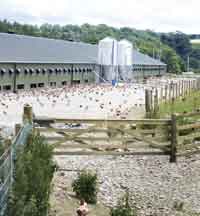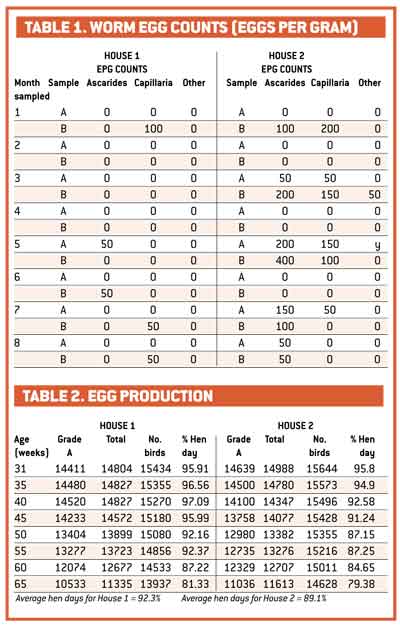Regular treatments can beat worms

Frequency of treatment plays a key role in getting on top of the worm burden in free-range flocks, as Philip Clarke reports
A significant improvement in layer productivity is achievable through more frequent worming, including through the drinking water, according to recent research on a commercial free-range flock.
The trial was established by animal health company Janssen – manufacturer of the two main worming products licensed for use on poultry in the UK, Flubenvet and Solubenol – and was designed to show the effectiveness of two different worming regimes.
The flock of 32,000, 30-week-old Lohmann birds, owned by BQ Farming Partnership at Selkirk, was split equally between two multi-tier systems, with each given a different treatment.

The first flock (House 1) received Flubenvet as an in-feed treatment every 10th week, and was also given Solubenol four-to-five weeks later, administered in the drinking water over a seven-day period.
The second flock (House 2) just received a seven-day course of Flubenvet in the feed, every 10 weeks.
The trial then ran for six months to analyse both the levels of parasitic infection and the effect of this on egg production.
Worm counts
Each multi-tier unit was split into two sections – A and B – and 60 fresh faecal samples were taken from each every month and analysed for worm egg counts (see Table 1).
“These counts showed a significant infection pressure on the farm, with both ascarid (roundworm) and capillaria (threadworm) being present,” said a spokesman for Janssen Animal Health. “Part way through the trial, syngamus (gapeworm) and tetramere were also identified in House 2.”
Overall, the worm burden was far higher in House 2, where treatment only took place with one product every 10th week.
Productivity
The research then went on to look at the impact on egg production (see Table 2).
Peak output occurred at 35 to 45 weeks of age, and there was a clear increase in egg production among the birds in House 1, which averaged 92.3% hen days during the course of the trial, compared with 89.1% for the birds in House 2.
The unit manager confirmed there was a difference of about 10 eggs per hen over standard production levels for those birds receiving the additional worm treatment. The 72-week target had been set at 310 eggs per bird, but actual production came to 320.
According to Janssen Animal Health, this equates to over £13,000 additional income, once the cost of the additional Solubenol treatment has been factored in.
“This case study shows that poultry keepers and producers should be aware of the worm challenge on their farms and treat according to infection pressure,” said the spokesman.
VET COMMENT
Eduardo Loedel-Soca of Inchcolm Veterinary Services says poultry keepers should do regular testing for parasitic infections and apply strict monitoring of any treatments they introduce.
“When used properly, worming treatments are very effective and can have a financial benefit,” he says. “But two things are absolutely crucial. The first is the way the hens have been reared. This is the stage at which they are developing their skeletal structures and organs. If things go wrong at this stage they will never be right.
“The second is the staff quality on the farm. As in this trial, personnel trained proficiently and working closely with the veterinarian can ensure that the medication is administered as prescribed. As with all medicines it is imperative to avoid under-dosing to ensure we reduce as much as possible the emergence of resistance strains while we achieve the therapeutic targets.”
The free-range sector is particularly prone to high worm infectious pressure, Mr Loedel-Soca adds, as the hens are regularly exposed to parasites just through ranging. And with the number of new entrants who have come into the sector – often general farmers with little practical experience of poultry – some may not be aware of the negative financial impact of this condition and may not be dealing with the problem effectively.
